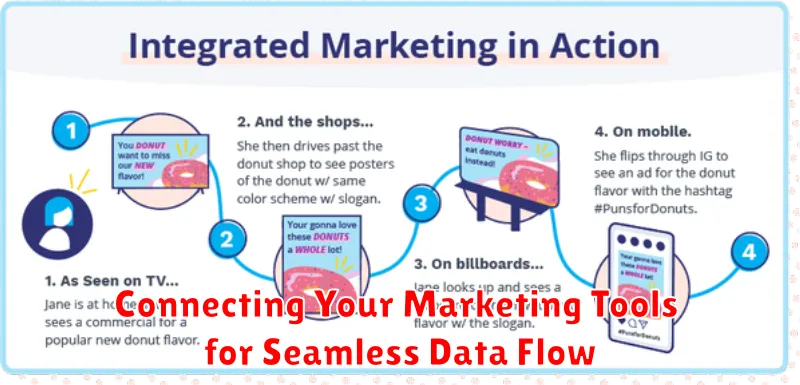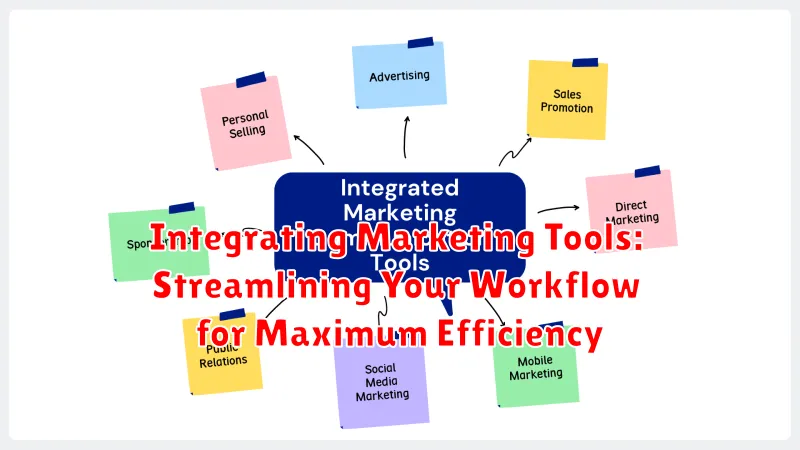In today’s dynamic business environment, integrating marketing tools is no longer a luxury, but a necessity for achieving maximum efficiency. Disparate marketing systems create data silos, hinder collaboration, and ultimately limit your ability to reach your target audience effectively. This article explores the essential strategies for streamlining your workflow through marketing tool integration, enabling you to optimize campaigns, improve data analysis, and boost your return on investment (ROI).
Learn how to connect your CRM, email marketing platform, social media management tools, and other marketing technologies to create a seamless and powerful marketing ecosystem. By effectively integrating marketing tools, you can unlock the true potential of your data, personalize customer experiences, and achieve maximum efficiency in your marketing operations. Discover how to eliminate redundant tasks, improve team communication, and gain a comprehensive view of your marketing performance by streamlining your workflow.
Identifying Your Marketing Needs and Goals
Before selecting and integrating marketing tools, it’s crucial to identify your specific marketing needs and define clear, measurable goals. Understanding your target audience is the first step. Who are you trying to reach, and what are their preferences?
Next, define your core marketing objectives. Are you focused on increasing brand awareness, generating leads, driving sales, or improving customer retention? Each objective will require different strategies and tools. Specificity is key. For instance, instead of aiming to “increase website traffic,” aim to “increase website traffic by 20% in the next quarter through targeted SEO efforts.”
Once you have a solid grasp of your target audience and objectives, you can start to evaluate your existing marketing activities. Which activities are currently effective? Where are the gaps in your strategy? Identifying these areas will inform your tool selection process and ensure you choose solutions that address your specific needs.
Choosing the Right Marketing Tools for Your Business
Selecting the appropriate marketing tools is crucial for maximizing efficiency and achieving your business objectives. A mismatched tool can hinder your workflow and waste valuable resources. The right tools, however, streamline processes and provide valuable data insights.
Begin by carefully considering your specific business needs. What are your primary marketing channels? Do you focus on social media marketing, email marketing, or content creation? Identifying your core activities will guide your tool selection process.
Next, evaluate the features and functionalities of different tools. Look for tools that address your specific requirements. Some tools specialize in social media scheduling, while others excel in email automation or SEO analysis. Integration capabilities are also crucial. Choose tools designed to connect with other platforms to ensure seamless data flow.
Budget considerations are also essential. Explore different pricing models and choose tools that fit within your allocated budget. Consider factors like the number of users, the level of support offered, and the available features when comparing pricing plans. A free trial or demo period can allow you to test the tool before committing to a subscription.
Connecting Your Marketing Tools for Seamless Data Flow

Connecting your marketing tools is crucial for a streamlined workflow and informed decision-making. A fragmented system leads to data silos, hindering your ability to see the complete customer journey. Integration allows data to flow freely between platforms, providing a holistic view of your marketing efforts.
Consider using a central hub, or a marketing automation platform, to connect your various tools. This central point acts as the primary repository for your data, facilitating cross-platform communication.
Identify the key data points that need to be shared between systems. Common examples include lead information, website analytics, email engagement, and social media interactions. Understanding these data flows will help you configure integrations effectively.
APIs (Application Programming Interfaces) are the backbone of most integrations. They allow different software applications to communicate and exchange data. Ensure your chosen tools have robust APIs and readily available documentation to simplify the integration process.
Automating Key Marketing Tasks with Integrations
Automation is where the true power of integrated marketing tools shines. By connecting your chosen platforms, you can streamline repetitive tasks, freeing up your team to focus on strategic initiatives.
Email marketing automation is a prime example. Triggers based on website activity or customer behavior can automatically send personalized emails, nurturing leads and driving conversions. Imagine a new subscriber receiving a welcome email instantly, followed by a series of targeted messages based on their interests – all without manual intervention.
Social media scheduling is another key area for automation. Pre-plan and schedule posts across multiple platforms, maintaining a consistent online presence even during off-hours. This ensures regular engagement with your audience without requiring constant monitoring.
Lead nurturing workflows can also be automated. When a lead interacts with your website or content, they can be automatically segmented and entered into a pre-defined nurture sequence. This ensures consistent follow-up and increases the likelihood of converting leads into customers.
Measuring the ROI of Your Integrated Marketing Tools
Measuring the return on investment (ROI) of your integrated marketing tools is crucial for demonstrating their value and optimizing your marketing spend. Accurate ROI measurement requires a clear understanding of your initial investment and the resulting returns.
Start by defining key performance indicators (KPIs) aligned with your business goals. These could include leads generated, conversions, website traffic, or sales revenue. Track these KPIs consistently across all integrated platforms.
Utilize analytics dashboards provided by your integrated tools to monitor performance and identify trends. Analyze the data to understand which integrations are contributing most significantly to your ROI. This data-driven approach allows for informed decisions about future investments and resource allocation.
Regularly review and refine your measurement strategies. As your business evolves, your KPIs and ROI calculations may also need adjustments to reflect changing priorities and market conditions.
Best Practices for Integrating Marketing Tools
Integrating your marketing tools effectively requires careful planning and execution. Start with a clear understanding of your business goals. Define what you want to achieve with integration, whether it’s improved lead generation, better customer service, or streamlined reporting. This clarity will guide your tool selection and integration strategy.
Prioritize data synchronization. Ensure seamless data flow between your tools to avoid data silos and maintain a single source of truth. This empowers informed decision-making and personalized customer interactions.
Focus on user adoption. Proper training and ongoing support are crucial for maximizing the value of your integrated tools. Equip your team with the knowledge and resources they need to utilize the tools effectively.
Regularly audit and refine. The marketing landscape is constantly evolving. Periodically review your integrated systems, identify areas for improvement, and adjust your integration strategy as needed to ensure optimal performance and alignment with your business objectives.
Troubleshooting Common Integration Issues
Integrating marketing tools can sometimes encounter roadblocks. Data discrepancies are a common issue, arising from varying data formats or incomplete synchronization between platforms. Troubleshooting involves verifying data integrity at each source and ensuring consistent formatting before integration.
API errors can disrupt the smooth flow of data between tools. Check API documentation for proper usage and authentication protocols. Examining error logs and consulting support resources can help pinpoint the root cause. Often, simple configuration adjustments or code revisions can resolve these issues.
Another frequent hurdle is lack of proper documentation. Comprehensive documentation is crucial for understanding the functionalities and limitations of each tool and how they interact. Before initiating integrations, thoroughly review available documentation and seek clarification on any ambiguities.
Finally, inadequate testing can lead to unforeseen problems after integration. Implement a robust testing strategy that includes unit testing of individual components and integration testing of the entire system. Thorough testing identifies potential conflicts and ensures seamless data flow across all platforms.
Building a Cohesive Marketing Tech Stack
A cohesive marketing technology (martech) stack is crucial for efficiency and data-driven decision-making. It’s more than just a collection of tools; it’s a carefully curated ecosystem where each component works harmoniously with others.
Start by identifying your core marketing objectives. What are you trying to achieve? Lead generation? Brand awareness? Customer retention? Your goals will dictate the types of tools you need.
Next, consider the essential categories for your stack, such as:
- Customer Relationship Management (CRM): The central hub for customer data.
- Marketing Automation: For automating repetitive tasks and nurturing leads.
- Analytics and Reporting: To measure campaign performance and ROI.
- Content Management System (CMS): To manage your website and content creation.
Choose tools that integrate seamlessly. Native integrations are ideal, but robust APIs can also bridge the gaps between different platforms. This interconnectedness allows for smooth data flow and prevents information silos.
Finally, prioritize scalability. As your business grows, your martech stack should be able to adapt and expand to meet your evolving needs.
The Future of Marketing Tool Integration

The future of marketing tool integration points towards a more seamless and interconnected landscape. Artificial intelligence (AI) will play a crucial role, automating tasks, personalizing customer experiences, and providing predictive insights. Expect to see more intelligent integrations that proactively adjust campaigns based on real-time data analysis.
No-code/low-code platforms are poised to democratize access to sophisticated integration solutions. These platforms empower marketers to connect tools and automate workflows without extensive coding expertise, reducing reliance on IT departments and accelerating implementation times. This also fosters greater agility and responsiveness to market changes.
A move towards unified data platforms is anticipated. These platforms will act as central hubs, aggregating data from various marketing tools and providing a holistic view of customer journeys. This consolidated data approach enables more powerful analytics, personalized messaging, and improved attribution modeling.
Finally, the increasing emphasis on privacy and data security will shape the development of future integrations. Expect more robust security features and compliance certifications as data privacy regulations evolve.

